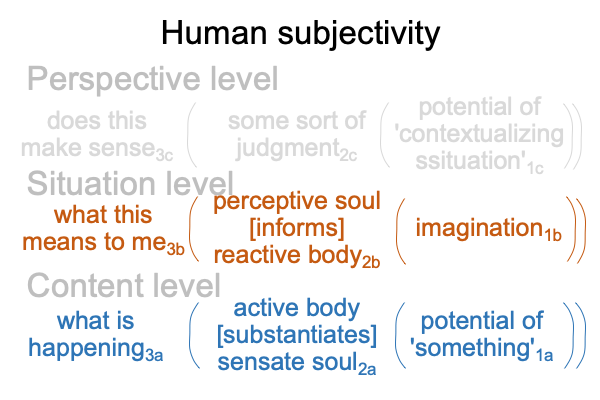0044 Ah, that brings me back to Houck’s book, which brings Aquinas’s concept of original justice out of its slumber.
If I look at the elements that associate with primary cause for both the content and situation levels, I see original justiceat work.
The content level is preternatural. From the very start, the human niche is not about some particular material feature of the environment of evolutionary adaptation. Triadic relations constitute an universal immaterial feature. Our sensations and feelings2a are tuned to the signs of nature (rather than some material thing in nature).
The situation level is full of grace. Like water, grace may come in flavors. Is sanctification a flavor of grace? I don’t know.
I do know that the production of a phantasm2b, where the perceptive soul [informs] the reactive body2b, requires synthesis, in addition to analysis. That explains why it2b is full of emotion. The reactive body2b externalizes what the perceptive soul1b internalizes. That accounts for why the phantasm2b is subject to correction.
Narrative3b is a normal context that facilitates such synthesis and analysis. Clearly, the Creation Story of Genesis does not ask us to situate our origins using Aristotle’s four causes. Rather, chapter one of Genesis calls us to imagine a possibility. Our phantasms2b are snapshots of what we think is going on. Imagination1b labels the potential of situating content1b.
Here is a picture with a noteworthy title.
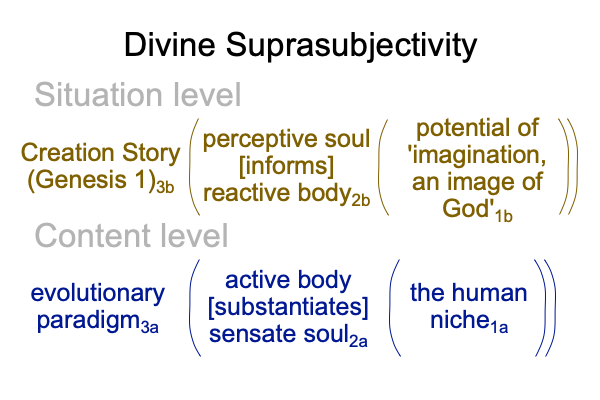
0045 So, Aquinas’s notion of original justice is compelling, especially when it comes to appreciating the Creation Story of Genesis as a sign of the evolutionary record.
Original justice must occupy a slot on the perspective levelc.
Original justice2c is intimated in the initial two-level interscope pictured above.
Original justice2c touches base with primary causation on the content and situation levels.
Original justice2c illuminates the normal contexts3a,3b and the underlying possibilities1a,1b.
0046 But, before I proceed to these topics, I want to step back and look at the actualities2a,2b associated with secondary causation. These actualities compose a model for the way that humans sensibly think, as they go about their daily lives, without paying attention to the perspective in which they operate. I would go as far to say that humans do not evolve to directly represent actualities such as original justice2c. They evolve to live them2c.
In the Lebenswelt that we evolved in, humans adapt to the potential of triadic relations1a, by constructing phantasms2bfrom sensations2a. Those sensations2a are stimulated by nature. They are also triggered by our own intentional manual brachial gestures2a. Our sensations2a are attuned to external and internal significations. Our phantasms2b construct internal objects, which our bodies react to.
So, when I encounter a turtle, my sensations and feelings construct an object, hey, this will cook up nicely, that causes my mouth to water. So, I gesture the words, here turtle, to a fellow teammate and my object2b becomes intersubjective.
0047 In sum, the content- and situation-level actualities2a,2b represent a portrait of the way humans are in the world.
Phantasms2b virtually situate sensations2a.
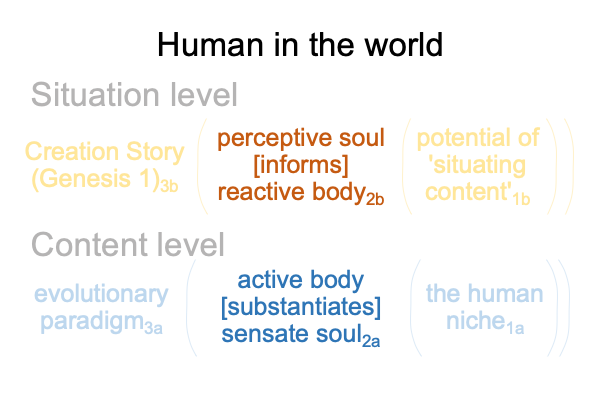
Here, I would like to pause an note that a scholastic diagram for how humans think appears in A Primer on The Individual in Community, by Razie Mah, available at smashwords and other e-book venues.
0048 Humans evolve to live in original justice2c.
Yet, we do not evolve to image or point to this perspective-level actuality2c.
We evolve to live within it2c.
0049 I now want to explore a picture of the human in the world.
It looks like this.
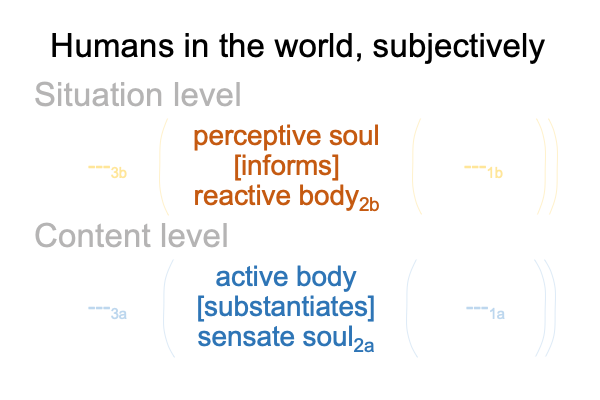
0050 What world am I writing about?
Is this world, the Lebenswelt that we evolved in?
Is this world, our current Lebenswelt?
It must be both, even though our current Lebenswelt is not the Lebenswelt that we evolved in.
0051 So, what is the difference between our current Lebenswelt and the Lebenswelt that we evolved in?
So far, the Biblical Creation Story tells me this. God declares that the Lebenswelt that we evolved in is good. So the primary causes, which are now empty slots, touch base with original justice.
But, once I pass Genesis 2:3, the Story of the Garden of Eden suggests that, with Adam’s rebellion, original justice is lost. It is just like a fairy tale, where an enchantment is lost, from one point of view, and insights are gained, from another point of view.
0052 So, the normal contexts3a,3b and possibilities1a,1b are empty for a reason.
In the Lebenswelt that we evolved in, these actualities2a,2b address hominins in the world.
In our current Lebenswelt, these actualities2a,2b present a picture of human subjectivity.
0053 Human are sensible. They take the perspective level for granted. Only when the situation goes horribly wrong do humans question their perspective. Indeed, our current capacity to question our perspective suggests that our situation has already gone horribly wrong.
0054 So I ask, “What give rise to sensations2a?”
Sensations and feelings2a emerge from (and situate) the potential of ‘something’1a in the normal context of what is happening3a.
0055 What about phantasms2b?
Emotional responses2b emerge from (and situate) the potential of situating content1b (that is, our imagination1b) in the normal context of what the content means to me3b.
0056 Here is a picture of human subjectivity (as opposed to God’s subjectivity).
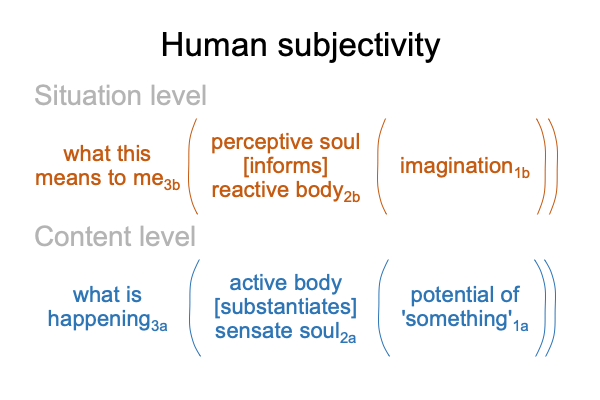
0057 Human subjectivity covers adaptations within the Lebenswelt that we evolved in. The Lebenswelt that we evolved inassociates to original justice and the Edenic tree of life. This sensible structure for human subjectivity remains intact as it passes to our current Lebenswelt.
Yet, there is a difference between our originating and current Lebenswelts.
In the first, our hominin ancestors live within a perspective level that they cannot image or indicate with their hand (and later, hand-speech) talk. So, the question arises concerning how our ancestors experience the signs of an unnamable perspective-level actuality2c.
In the latter, we have a way of talking, speech-alone talk, that is primarily symbolic. Consequently, we can explicitly abstract and label the elements of our perspective-level actuality2c. Uh-oh. Does that suggest that we can generate our own perspective-level actualities, that don’t even come close to the originating original justice2c?
0058 With that question left on the table like an apparently dead turtle, allow me to introduce a picture of the content and situation levels along with the currently obscured perspective level for human subjectivity.
